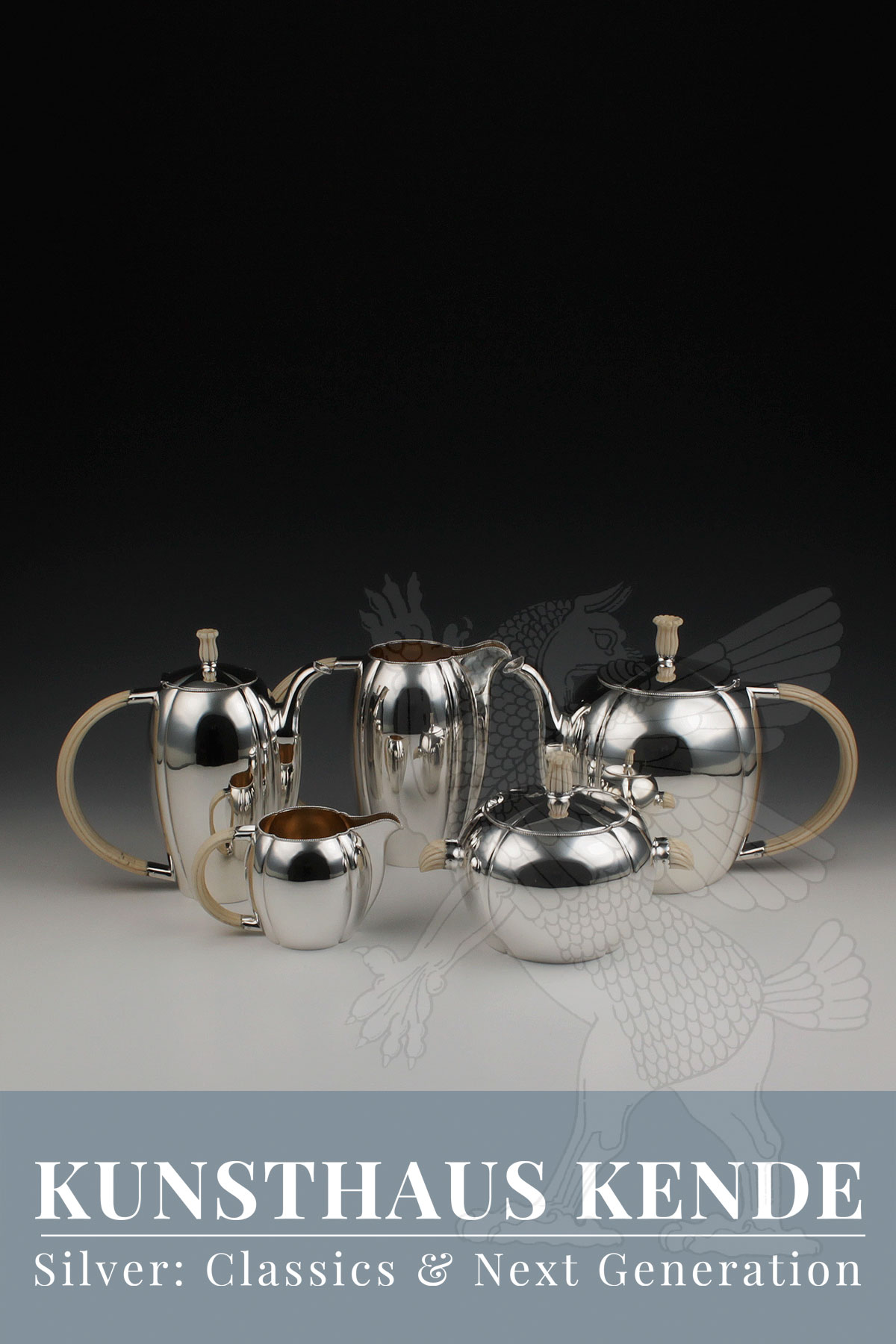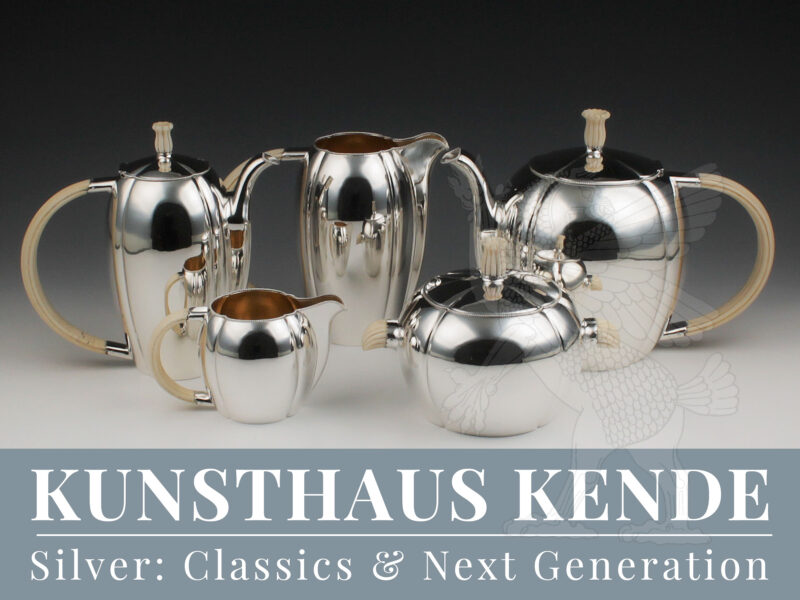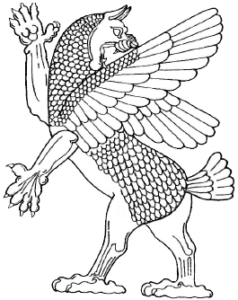Item number: 59066
An exceptional 800 grade silver coffee and tea service, Vienna 1909-12,
designed by Hans Bolek, executed by Franz Schediwy for Alfred Pollack silversmithy
The curved bodies, divided into four vertical folds, extending to the upper third and merging into the rounded shoulder which is decorated with a pearl frieze. The coffee pot and tea pot, as well as the sugar bowl are covered by a slightly dome-shaped lid and crowned by ribbed ivory lid knobs. The spouts of the coffee pot and teapot as well as the hot milk and hot water jug are analogously decorated with beaded rims on their edges. The teapot as well as the coffee pot, the large milk jug (or hot water jug) and the creamer with widely curved, semicircular ivory handles ornamented with fluted profiling. The sugar bowl with conical handles.
An exceptionally rare and high-quality Viennese Art Nouveau coffee and tea service, whose high quality of manufacture is not only evident in the solid weight of the individual objects, but also in their craftsmanship: the handles and the lid knobs have semi-circular decoration on the rim, which has been worked into the sockets of the handles and lid knobs in negative form to create a harmonious transition.
Teapot:
25.4 cm / 10″ length, 15 cm / 5.90″ width, 18.8 cm / 7.40″ tall; 902.9 g / 29.02 oz, 1.95 ltr. capacity (!)
Hot milk or hot water jug:
18.6 cm / 7.32″ length, 9.2 cm / 3,62″ width, 16 cm / 6.29″ tall (to the tip of the spout); 441.1 g / 14.18 oz, 0.8 ltr. capacity
Coffeepot:
19.2 cm / 7.55″ length, 9.2 cm / 3.62″ width, 18.5 cm / 7.28″ tall; 561.5 g / 18.05 oz
Creamer:
14.3 cm / 5.62″ length, 8.6 cm / 3.38″ width, 8.4 cm / 3.30″ tall; 213.5 g / 6.86 oz
Sugar bowl:
18.3 cm / 7.20″ length (between the handles), 13.4 cm / 5.27″ width, 12.5 cm / 4.92″ tall; 507.3 g / 16.31 oz
Hans Bolek (1890 Vienna – 1978 ibid.)
Important architect, painter and designer of decorative art. Hans Bolek studied at the Vienna School of Applied Arts from 1906 to 1910 under Josef Hoffmann, with whom he remained on friendly terms throughout his life and worked together from 1939 to 1941. After his studies, he started his own business as an architect and became known for his urban buildings. Bolek was a co-founder of the Austrian Werkbund (founded in 1914) and worked for Alfred Kurz for a time after having worked in Otto Prutscher’s architectural office. Immediately after the Second World War, Hans Bolek was given a teaching post at the Vienna Fashion School, which he held until 1962. As a universal designer of arts and crafts, Bolek designed furniture for the Viennese art furniture factory August Ungethüm and ceramics for the companies Wahliss and Böck. He became well known for his designs for the famous glassblowing company Loetz Witwe in Klostermühle. He also created individual designs for silverware such as tea sets and centrepieces as well as for jewellery which were realised by the important gold- and silversmithy Oskar Dietrich. From 1972 until his death, Hans Bolek only appeared in painting and graphic art. Although he was never a member of the Wiener Werkstätte, individual designs by Hans Bolek were executed in silver until 1914. His affinity with the Wiener Werkstätte resulted not least from his friendship with Josef Hoffmann. In view of his high artistic productivity, there are relatively few documented works in silver by Hans Bolek. In addition to Oskar Dietrich, the famous silversmiths Eduard Friedmann, Alfred Pollack and Hermann Südfeld also realised individual designs by Bolek which are among the finest silver works of Viennese Art Nouveau.
This tea service was designed pre 1909 and exhibited for the first time by the silversmith Alfred Pollack in 1910/11 at the winter exhibition in the Vienna Museum of Applied Arts (today Museum der angewandten Kunst, Vienna, known as MAK). In 1912, the Vienna Museum of Applied Arts acquired the tea service, consisting of a teapot, milk jug and sugar bowl on a tray. It is still in the museum’s collection under inventory number WI 1102 (see here). The silversmithy Alfred Pollack initially had the coffee tea service made in the silversmith’s workshop of Franz Schlesinger, who died in 1909. Franz Schediwy’s silversmithy was then commissioned to make it. The service in the possession of the MAK was, like our service, executed by Franz Schediwy. While the MAK owns the three-piece tea service, our service is available in the very rare variant as a complete five-piece coffee tea service. An identical composition to the coffee tea service we offer is in the Bröhan Museum, Berlin and is illustrated in: Kerssenbrock-Krosigk, D. von, Bröhan Museum, von Kerssenbrock-Krosigk, D. & Kanowski, C. (2001). Metallkunst der Moderne: Bröhan-Museum, Landesmuseum für Jugenstil, Art Deco und Funktionalismus (1889-1939), Berlin. P. 521, cat. No. 464 . On the service in the MAK see, among others, Neuwirth, W. (1977, October 11). Lexikon Wiener Gold- und Silberschmiede und ihre Punzen 1867-1922. Neuwirth, W. [self-published]. P.179, plate 58 (above). Apart from these two works, we know of no other versions of this design in museum possession, which underlines its rarity.





